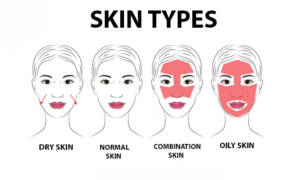Everyone’s body is unique, and what works for one person may not work for another. By identifying your specific skin type and understanding how certain foods affect it, you can personalize your diet to optimize your skin health.

Normal Skin: This skin is neither overly dry nor overly oily, has an even tone and is smooth to touch.
Dry Skin: This skin does not have enough sebum or moisture and can become tight, itchy, red, and flaky. Due to lack of moisture, it may take on a leathery appearance during maturity. Factors that contribute to dry skin include constant exposure to low humidity, air conditioning, and heating in office & home and certain chemicals in skin-care products.
Eat: foods rich in essential fatty acids, vitamins A, D, E, zinc. Vitamin A & E-rich foods repair and replenish damaged skin cells, while healthy fats and essential fatty acids have an anti-inflammatory action that reduces redness and helps to restore sebum. Hydrating foods like cucumbers, watermelon, and citrus fruits have high water content and can contribute to overall skin hydration.
Avoid: coffee, colas & alcohol as they can have dehydrating effects on the body, leading to further dryness of the skin; spicy foods and excessive salt aggravate dry skin and cause further irritation; highly processed foods and sugary snacks can promote inflammation and potentially worsen dry skin condition.
Oily Skin: This skin looks shiny and coarse due to over-active sebaceous glands that produce a surplus of oil. Oily skin may not be necessarily oily all the time and may depict shiny patches on the nose, forehead, or chin during midday. This skin type also shows enlarged pores and a thick texture and is prone to acne.
Eat: foods rich in zinc for skin repair; omega 3 rich foods to balance sebum; and nutrient-dense antioxidant rich foods like berries, leafy greens, and tomatoes to help keep skin clear, combat free radicals and reduce inflammation.
Avoid: Fried foods as they can contribute to excess sebum production and potential breakouts; high sugar foods & beverages can cause blood sugar spikes, triggering inflammation and potentially exacerbating acne; dairy products as some studies suggest a link between dairy consumption and acne breakouts in certain individuals, likely due to the hormones present in milk products; processed foods can contribute to overall inflammation and may negatively impact skin health.
Combination Skin : This skin is a mixture of dry and oily skin types. Such complexions are oily in the T-zone area (the forehead, nose, and chin) and dry on the cheeks.
Eat: protein rich foods that repair and renew skin and foods high in anti-inflammatory essential fatty acids, zinc, and natural pro- and prebiotics help to balance sebum and restore vitality.
Avoid: Processed & fried foods, too much dairy, wheat, and sugar as they can increase sebum production.
Sensitive Skin: This skin is thin, easily irritated, prone to redness and inflammation and could be painful to touch. It may develop pustules, bumps, become inflamed, flush, and have weakened capillaries that cause thread veins.
Eat: Antioxidant quercetin rich foods (onions, apples, grapes, berries, broccoli, citrus fruits, cherries, green tea) and essential fatty acids that calm irritated skin.
Mature Skin: Skin thins as we age, becoming drier as sebum production falls, and less supple, as collagen and elastin production reduces.
Eat: foods rich in essential fatty acids; complete proteins and antioxidant rich foods to protect skin against UV rays and boost circulation.
Avoid: foods rich in sugar, processed foods and alcohol.
While adjusting your diet alone may not be a cure-all for skin issues, it can complement other skincare practices and contribute to healthier skin overall. It’s important to note that dietary changes may take time to show noticeable effects, so consistency is key.
| Nutrient | Food sources |
| Vit A (Retinol) | Liver, egg yolk, butter, whole milk, and cheese. |
| Vit A (Beta carotene) | Sweet potato, carrots, pumpkin, bell peppers spinach, corn, fenugreek leaves, mustard leaves, lettuce, bathua, mint, broccoli, musk melon, pineapple, mangoes, papaya, orange, watermelon, apricot, peach. |
| Vit C | Amla, guava, lemon, kiwi, orange, mausmi, papaya, lemon, strawberries, pineapple, potato, sweet potato, capsicum, bell peppers, broccoli, green chillies, tomatoes, cauliflower, cabbage, lettuce |
| Vit D | Egg yolks, mushroom, tofu, cheese, milk, curd, soymilk, salmon, sardines, canned light tuna, herring, mackerel |
| Vit E | Edible vegetable oils, sunflower seeds, pumpkin seeds, almonds, pine nuts, peanuts, walnuts pistachios, cashew nuts, egg yolk, avocado, olives. |
| Zinc | Red meats, shellfish, quinoa, legumes, beans, oats, mushroom, asparagus, spinach, pumpkin seeds, sesame seeds, flax seeds, sunflower seeds, chia seeds, alfa-alfa sprouts, peanut, cashew, almonds |
| Essential fatty acid – Omega 6 | Corn oil, sunflower oil, safflower oil, canola oil, soybean oil, mustard oil, fish, poultry, pine nut, chia seeds, flax seeds |
| Essential fatty acid -Omega 3 | Fish such as mackerel, salmon, tuna, sardines, oysters, canola oil, mustard oil, soybean oil, walnut, flax seeds, chia seeds, wheat germ, egg, green leafy vegetables, fenugreek seeds, mustard seeds, legumes, bajra, soybeans |



